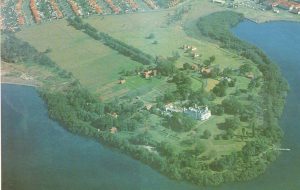Sydney’s best kept secret
Yaralla Mansion
The Yaralla Estate is significant in the evolving pattern of occupation of the colony, starting with a grant to an ex-convict, then developing as a working farm, continuing as a Victorian estate, early twentieth century Edwardian estate, and mid twentieth century to current times as an institution facility.
It is historically significant as one of the last large nineteenth century estates remaining in metropolitan Sydney. It is of rare State significance because it incorporates an entire 1790s land grant within its boundaries.
The land was originally granted, in 1797, to Isaac Nichols, a convict-turned-businessman, who became the colony’s first postmaster. It was on this land that he established extensive orchards and vegetable gardens which supplied fruit and other produce to the colony.
Woodbine Cottage
Following Isaac Nichols’ death the estate passed to his family, who built a small wooden cottage, “Woodbine”, there in the early 1830s. This cottage, although much altered, still stands in the grounds of Yaralla.
The estate has important association with the Walker family – Thomas Walker, an important nineteenth century merchant, politicians and landholder and his daughter Eadith, were noted for their philanthropic activities in the early twentieth century. Their links with Concord began when Thomas Walker obtained a mortgage on the Nichols’ estate in about 1840 and continued for almost a century until the death of his daughter, then Dame Eadith, in 1937.
The house played an important part in social and cultural life in the early twentieth century.
Yaralla House represents the work of two of Australia’s major nineteenth century architects; Edmund Blacket and John Sulman.
In the 1857, Thomas Walker commissioned Edmund Blacket to design a “cottage” on the low rise adjacent to the Parramatta River. Thomas was very involved in the establishment of the gardens at Yaralla, engaging notable head gardeners such as Alexander Stephen, who was attributed with introducing the ‘ribboning system’ of garden bedding in the colonies. Upon Thomas’ death his ultimate philanthropic gesture was the 100,000 pounds he left for the building of the Thomas Walker Convalescent Hospital.
Eadith made extensive alterations in 1893-99, using the services of architect and relative-by-marriage, John Sulman. Sulman also designed several of the outbuildings, particularly the stables complex and the dairy building.
Following Dame Eadith Walker’s death, the land comprising the Dame Eadith Walker Convalescent Hospital (Yaralla Estate) became vested in the Crown under the Walker Trusts Act 1938. This Act gives the Royal Prince Alfred Hospital (now Sydney Local Health District) responsibility for the control, management and administration of the Hospital. It is the largest community bequest of its era to survive in an intact form in New South Wales.
The Thomas Walker Convalescent Hospital (now Rivendell) and the Yaralla Cottages were also part of the bequest and the Walker Trust Fund, administered by the Perpetual Trustee Company, still provides for maintenance on these properties.
The significance of the estate has been recognised by the making of a Permanent Conservation Order under the NSW. Heritage Act. The estate is listed on the Register of the National Estates, classified by The National Trust of Australia (NSW) and is also listed as an item of Environmental Heritage by the Concord Municipal Council.
If you would like to put your name down on a waiting list to be notified of the next tour of this magnificent estate complete the form below. We will contact you approximately two months prior to the date to give you details.
To enquire about the use of the Yaralla grounds for photography or any other use, use this link to the Sydney Local Health District Yaralla Estate website.



